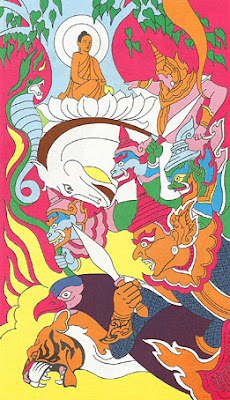The relative freedom in the orientation was characteristic of the architecture of the early Bagan times.
, read more.
 |
The Victory over Mara
|
Most interesting are the 400 works that adorn the upper terraces, they illustrate the last ten big Jatakas, each of them are 40 reliefs and text in the old Mon language. On the lower railing of the pyramidal superstructure are 537 tiles that illustrate the same but with with inscriptions in Pali.
On the west side of the building, the army of the Mara demons is shown threatening the Buddha, and on the east side the Bodhisattva praised by the gods after his victory over Mara. The inscriptions in the compositions containing the names of the persons and the names of the depicted object.
This sacred shrines were called "Gu",
which means cave temple, this name corresponds to the character of the interior which is basically a hall. The peace and tranquility prevailing there should help to achieve the aspired state of introspection and recollection. The image of the quiet hermitage, away from the bustle of the world, agreed wholeheartedly with the basic tenets of Buddhism calling to get rid of all earthly conditions and desires. Entering building is also a great relief after the heat outside, it’s cool in the semi-darkness of the interior.
Here is a real old fashioned cave temple
 |
| Powintaung Cave Temples near Monywa |
The walls were decorated in accordance with the local tradition, this are almost always mural or wall paintings which are sometimes not in good conditions, cleaning and restoration is a continues task. Many murals are not visible very good while the sculptural decoration is visible without problems. This monument could be seen as veritable sculptures and relief museum of medieval Burma, and every plastic and structure is assigned to carry a particular visual content.
 |
| Jakata Wall relief |
At each of the four entrance portico are reliefs, each representing the eight major events in the life of Gautama Buddha and repeated accordingly. These subjects are widespread, with an accurate and consistent iconography.
These eight scenes are considered the most important in his life and their repetition was hardly accidental, the people have attached particular importance to these pictures.
The corridor around the central pillar has two rows of 80 niches embedded in the solid wall, where sandstone reliefs show the life of Gautama Buddha before his enlightenment. All figures are covered with gold leaf, with red on the background. These reliefs sequentially depict events from the life of Prince Siddhartha, who became a hermit at the age of 29 and with 35 years a Buddha.
The cycle begins with the presentation of the King Suddhodhana, father of him who, as the - albeit controversial - inscription under the relief tells sit together with Maya, the mother of the Bodhisattva, and her sister in the palace at Kapilavastu, there are different interpretations of this scene. One thing is certain, the artists of that time dealt very freely with the sacred Buddhist texts.
The description above gives only a small part of this comprehensive narrative, the compositional schemes are manifold. Some of them are very laconic others more complex.
 |
| Temple "Guardian" |
Over centuries, the Temple captivates the attention of researchers. The first one to measure and describe it in 1855 was the British officer and scholar Henry Yule. The measurements of the Ananda Temple made by him very carefully have not lost their value.












No comments:
Post a Comment